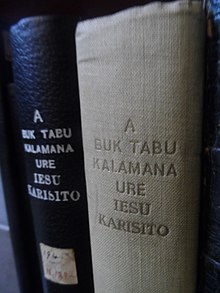| Tolai | |
|---|---|
| Kuanua | |
| Tinata Tuna | |
| Native to | Papua New Guinea |
| Region | Gazelle Peninsula, East New Britain Province |
| Ethnicity | Tolai |
| Native speakers | (61,000 cited 1991) 20,000 L2 speakers |
| Language family | Austronesian
|
| Writing system | Latin script (Tolai alphabet) Tolai Braille |
| Language codes | |
| ISO 639-3 | ksd |
| Glottolog | kuan1248 |
The Tolai language, or Kuanua, is spoken by the Tolai people of Papua New Guinea, who live on the Gazelle Peninsula in East New Britain Province.
Nomenclature
This language is often referred to in the literature as Tolai. However, Tolai is actually the name of the cultural group. The Tolais themselves refer to their language as a tinata tuna, which translates as 'the real language'. Kuanua is apparently a word in Ramoaaina meaning 'the place over there'.
Characteristics

Unlike many languages in Papua New Guinea, Tolai is a healthy language and not in danger of dying out to Tok Pisin, although even Tolai suffers from a surfeit of loanwords from Tok Pisin; e.g. the original kubar has been completely usurped by the Tok Pisin braun for 'brown', and the Tok Pisin vilivil for 'bicycle' has replaced the former aingau. It is considered a prestigious language and is the primary language of communication in the two major centers of East New Britain: Kokopo and Rabaul.
Tolai lost the phoneme /s/. For instance, the word for 'sun' in closely related languages of South New Ireland is kesakese, and this has been reduced to keake in Tolai. However, /s/ has been reintroduced through numerous loanwords from English and Tok Pisin.
Classification
Tolai belongs to the Oceanic branch of the Austronesian language family. The most immediate subgroup is the Patpatar–Tolai group of languages which also includes Lungalunga (also spoken on the Gazelle Peninsula) and Patpatar (spoken on New Ireland).
Geographic distribution
Tolai is spoken on the Gazelle Peninsula in the East New Britain Province of Papua New Guinea.
Derived languages
Tolai is said to be one of the major substratum languages of Tok Pisin. Some common Tok Pisin vocabulary items that likely come from Tolai (or a closely related language) include:
- aibika (from ibika) - Hibiscus manihot
- buai - 'betelnut'
- diwai (from dawai) - 'tree, wood'
- guria - 'earthquake'
- kawawar (from kavavar) - 'ginger'
- kiau - 'egg'
- lapun - 'elderly person'
- liklik (from ikilik) - 'small'
- umben (from uben) - 'fishing net'
Grammar
Phonology
Phonology of the Tolai language:
| Labial | Alveolar | Velar | ||
|---|---|---|---|---|
| Nasal | m | n | ŋ | |
| Plosive | voiceless | p | t | k |
| voiced | b | d | ɡ | |
| Fricative | β | s | ||
| Liquid | rhotic | r | ||
| Lateral | l | |||
| Semivowel | (w) | |||
| Front | Central | Back | |
|---|---|---|---|
| High | i | u | |
| Mid | e | o | |
| Low | a |
Vowel sounds can also be realised as . /i/ can be pronounced as in word-initial position.
Independent pronouns
Tolai pronouns have four number distinctions (singular, dual, trial and plural) and three person distinctions (first person, second person and third person) as well as an inclusive/exclusive distinction. There are no gender distinctions.
| Singular | Dual | Trial | Plural | ||
|---|---|---|---|---|---|
| 1st | exclusive | iau (I) |
(a)mir (he/she and I) |
(a)mital (both of them, and I) |
avet (all of them, and I) |
| inclusive | - | dor (thou and I) |
datal (both of you, and I) |
dat (all of you, and I) | |
| 2nd | u (thou) |
(a)mur (you two) |
(a)mutal (you three) |
avat (you guys) | |
| 3rd | ia (he/she) |
dir (they two) |
dital (they three) |
diat (they) | |
The plural pronouns lose their final -t when used before a verb.
- Da vana! - 'Let's go!'
- Pa ave gire. - 'We didn't see.'
- Dia tar pot - 'They have already arrived.'
Syntax
The usual word order of Tolai is agent–verb–object (AVO/SVO).
Morphology
There is an irregular pattern involving the prefix ni-, which changes a verb to a noun. Ordinarily, the prefix is added to the verb, as in laun 'to live' → a nilaun 'the life', ian 'to eat' → a nian 'the food', aring 'to pray' → a niaring 'the prayer'. However, in some cases it becomes an infix ⟨in⟩: varubu 'to fight' → a vinarubu 'the fight', tata 'to talk' → a tinata 'the language', mamai 'to chew betelnut' → a minamai '(a small supply of) betelnuts for chewing'. This infix is inserted after the initial phoneme of the verb. It could also be described as the prefix ni- being added as a prefix, and the initial phoneme of the verb changing places with the n of the prefix.
Notes
- Tolai at Ethnologue (18th ed., 2015) (subscription required)
- Franklin, Karl J.; Kerr, Harland B.; Beaumont, Clive H. (1974). Tolai Language Course (third ed.). Ukarumpa, Papua New Guinea: Summer Institute of Linguistics. ISBN 0-88312-207-3.
References
- Mosel, Ulrike (1984). Tolai Syntax and Its Historical Development. Canberra: Pacific Linguistics. doi:10.15144/pl-b92. hdl:1885/145237. ISBN 978-0-85883-309-8.
- Lynch, John; Ross, Malcolm; Crowley, Terry (2002). The Oceanic Languages. Richmond, Surrey: Curzon Press.
External links
- Tolai Language Course
- Language Museum page on Tolai
- A number of collections in Paradisec include materials in Tolai
| Languages of Papua New Guinea | |||||||||||||||||||||||||||||||||
|---|---|---|---|---|---|---|---|---|---|---|---|---|---|---|---|---|---|---|---|---|---|---|---|---|---|---|---|---|---|---|---|---|---|
| Official languages | |||||||||||||||||||||||||||||||||
| Major Indigenous languages |
| ||||||||||||||||||||||||||||||||
| Other Papuan languages |
| ||||||||||||||||||||||||||||||||
| Sign languages | |||||||||||||||||||||||||||||||||
| Meso-Melanesian languages | |||||||||||||||||||
|---|---|---|---|---|---|---|---|---|---|---|---|---|---|---|---|---|---|---|---|
| |||||||||||||||||||
| |||||||||||||||||||